Ijraset Journal For Research in Applied Science and Engineering Technology
- Home / Ijraset
- On This Page
- Abstract
- Introduction
- Conclusion
- References
- Copyright
Production of SCC Using Bagasse Ash as Fine Aggregate
Authors: S. Sathishkumar, Mrs. P. Somiyadevi, S. Maluvu
DOI Link: https://doi.org/10.22214/ijraset.2023.56009
Certificate: View Certificate
Abstract
In this study an experimental investigation on production of self-compacting concrete with bagasse ash as partial replacement of fine aggregate is done. River sand has been partially replaced with bagasse ash from 0% to 80% by volume. Cement and fly ash is used as a powder material. Two concrete mixtures with cement content of 375 Kg/m3 and 500 Kg/m3 was proportioned. The workability properties such as slump flow, inverted flow, V-funnel flow time and J-ring flow were measured. The hardened properties such as density, compressive strength, split tensile strength, modulus of elasticity and flexural strength of concrete in each mixture were measured at various ages. Water absorption and weight loss ratio on drying of concrete was measured at 28 days. Micro structural properties such as SEM and XRD analysis were examined for SCC specimens.From the test results, it was found that (a) Workability properties depends upon the bagasse ash content (b) Partial replacement of BA up to 20% by volume of bagasse ash enhanced both the workability and hardened properties of self-compacting concrete (c) SEM micrograph images shows that irregular porous particles increases as BA increases and XRD pattern reveals that presence of silica peak increases as the BA content increases from 10% to 80%.
Introduction
I. INTRODUCTION
The main parameter which has greater influence on the economy and the durability of the concrete structures are the quality and the density of the concrete cover as well as the compaction of the concrete. For this, self-compacting concrete (SCC) offers new possibilities and prospects. Self compacting concrete is a highly flow able concrete which does not segregate and can spread into place, fill the form work with heavily congested reinforcement, and encapsulate the reinforcement without any mechanical vibration. The present procedure for the production of SCC is predominantly empirical. The mix design is based on the experience from Japan, Netherlands, France and Sweden. SCC is a generic term for mix designs that differ from traditional concretes at the molecular interface between the cement compounds and the admixture polymers. The fluidity of SCC ensures a high level of workability and durability whilst the rapid rate of placement provides an enhanced surface finish. SCC is certainly the way forward for both in situ and precast concrete construction.
Production and control of SCC is very demanding. Compared to traditional concrete SCC has proven much more difficult to control both the flowing properties and stability at the same time. It may be difficult to obtain a high flow ability without segregation occurring. Therefore, it is important to put much effort in optimization of the whole concrete composition from particle composition to water and super plasticizer concentrations.
II. LITERATURE REVIEW
Self-compacting concrete is a non-vibratory concrete which can attain full compaction by its own weight, reduce construction time & labor requirements. Various industrial by products such as quarry dust, bagasse ash, recycled fine aggregates, RHA etc., are partially replaced for sand for economy, environmental issues and to avoid depletion of natural resources. Addition of quarry dust gradually increases slump flow up to 100% replacement level of river sand in SCC [1]. Compressive strength is about 15% higher at 100% replacement of QD when compared to 0% replacement. Slump flow of SCC with rice husk ash (RHA) partially replaced for sand up to 40% satisfies EFNARC guidelines [2]. Above 40% RHA level, extreme blockage greater than 50mm was noticed at J-ring. When limestone (LS) powder was added to SCC, J ring values were enhanced up to 60% RHA level. Compressive strength of concrete was decreased with increase in percentage of RHA level and it was about 19% lower than control SCC [3]. Use of bagasse ash as partial replacement of fine aggregate in SCC results in increase in water requirement of SCC mixtures which is about 35% higher than mix with both BA & LS due to the porous nature of the BA particles and their greater surface area. Unit weight of concrete mixtures decreased to about 12% with increasing BA content, due to increase in porosity [4].
The workability properties of SCC mixtures containing bagasse ash are enhanced with the addition of limestone powder. Slump flow was at acceptable range for partial replacements of BA up to 60% for fine aggregate [5]. The compressive strength of SCC mixtures with BA was comparable up to 20% replacement and gradually decreases with increase in percentage of BA replacement. Compressive strength of BA & LS mixture is about 27% higher than the mix with BA as fine aggregate [6]. Literature study reveals that studies on production of SCC with fly ash and bagasse ash has not been reported so far [7,8].
III. MATERIALS
A. Cement
Ordinary portland cement of 53 grade confirming to IS 12269-1976 is used in this project work. The physical properties of the cement used in this work were tested in accordance with IS: 4031-1988 and the test values are given in the Table 1


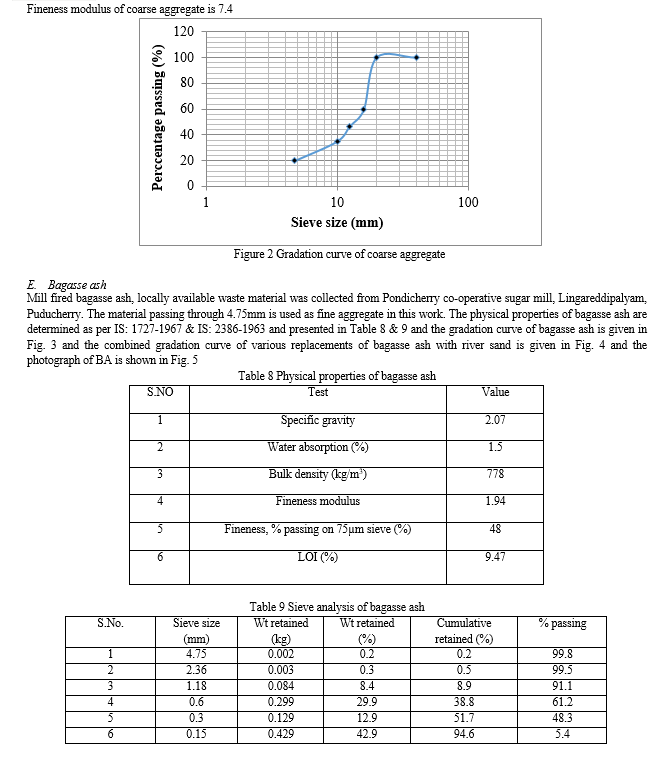
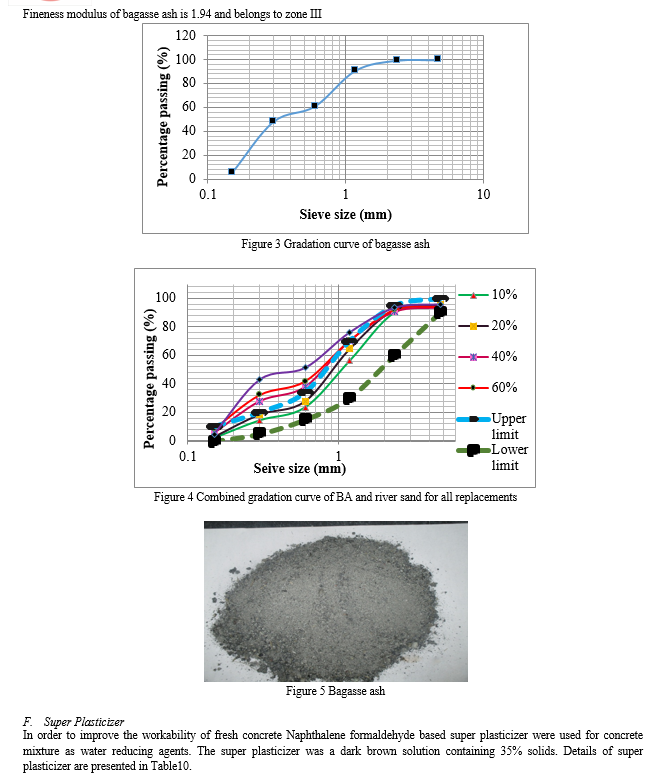


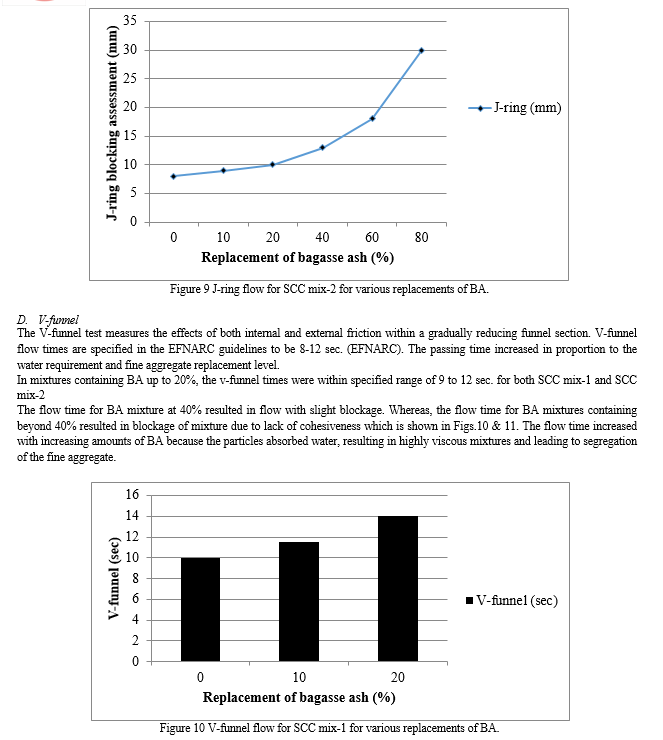
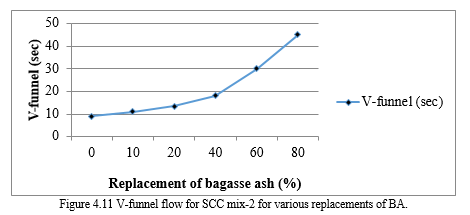
E. Compressive Strength
The compressive strength results of self compacting concrete for various partial replacement percentage of BA to river sand were found at 3, 7, 28 and 60 days. The test results reveal that the compressive strength of SCC mix-1 ranges from a minimum of about 19.12MPa to a maximum of about 54.36MPa at 28 days. And the compressive strength of SCC mix-2 ranges from a minimum of about 31MPa to a maximum of about 58.3MPa. The results show that the strength development is related to the partial replacement of BA. The compressive strength of both SCC mixture specimens at each age are plotted in Figs.12 to 16. The compressive strength continued to increase as the curing age increases. At later ages (28 and 60 days), rate of increase in compressive strength was found to be higher due to the pozzolanic reaction which develops strength at later ages. In general, compressive strength was increased with increase in partial replacement of BA up to 10%. Compressive strength achieved at 20% of BA was almost equivalent to reference mixture. Compressive strength was found to be decreased beyond 20% of BA. The above trend was same for all mixtures irrespective of age. The decrease in strength was about 52% to 63% for 40% to 80% replacement of BA when compared to reference SCC mix-1. The decrease in strength was about 29% to 43% for 40% to 80% replacement of BA when compared to reference SCC mix-2. Addition of increasing amount of BA generally decreased the strength at a given age due to the greater porosity of the material as indicated by higher water requirement (Rashad et al, 2013).Compressive strength at 10% of BA is 5.4% and 7.4% higher when compared to reference SCC mix-1 and reference SCC mix-2 respectively. Maximum compressive strength of about 58.3MPa was obtained at 10% replacement for SCC mix-2. At 80% replacement of BA the decrease in strength was about 63% when compared with reference SCC mix-1. Comparing the compressive strength results of SCC mix-1 and SCC mix-2 at 28 days the rate of decrease in strength was observed to be lesser for SCC mix-2 when compared with SCC mix-1. The compressive strength of SCC mix-2 was found to be higher when compared with SCC mix-1.
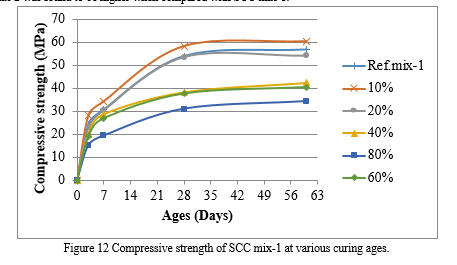
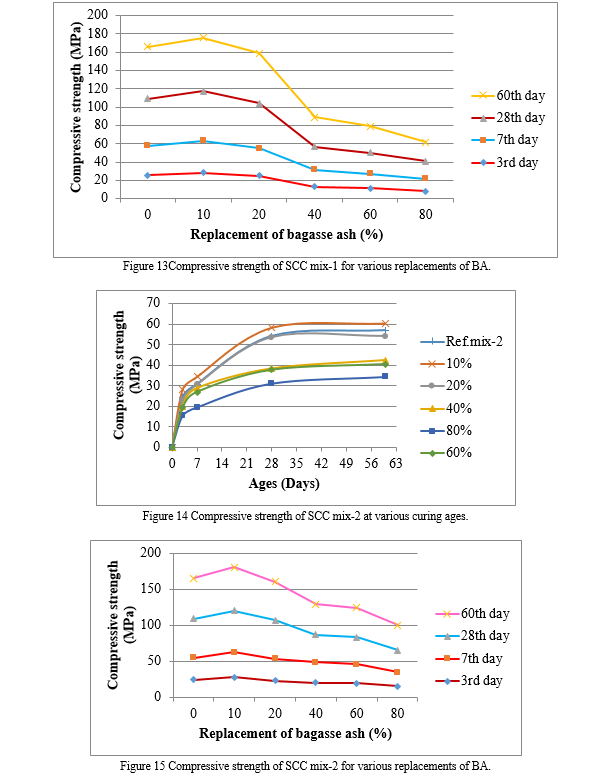

F. Split Tensile Strength
Split tensile strength is one of the most important fundamental properties of concrete. An accurate prediction of split tensile strength of concrete will help in mitigating cracking problems, improve shear strength prediction and minimize the failure of concrete in tension. Split tensile strength developed for SCC mix-1 and SCC mix-2 specimens with BA percentage varying from 0% to 80% are shown in Figs.17 &18. For reference SCC mix-1 the split tensile strength ranges between 2MPa and 3.1MPa at 7 and 28 days. At 10% replacement of fine aggregates with BA strength were observed to be in the range of about 2.73MPa at 7 days and 3.87MPa at 28 days and it was about 1.53MPa and 2.72MPa at 20% of BA when compared to reference SCC mix-1. The test results show that the split tensile strength increases at 10% of BA and it was comparable at 20% of BA at various curing ages when compared with reference SCC mix-1. The test results reveal that the split tensile strength of SCC mix-2 specimens ranges from a minimum of 2.72MPa to a maximum of 3.87MPa at 28days. For reference SCC mix-2 the split tensile ranges between 2.3MPa and 4.22MPa at 7 and 28 days. According to the test results, split tensile strength values at 28 days are comparable up to 20% of BA and decreases by about 20% to 50% for replacement ratios of 40% to 80% of BA respectively. Split tensile strength tends to decrease with the increase in percentage of BA beyond 20%. Evidently these results agree with Prashant et al, 2013.
Maximum split tensile strength of about 4.22MPa was obtained for SCC mix-2. At 80% of BA the decrease in strength was about 50% compared to reference SCC mix-2. Rate of decrease in split tensile strength was higher at later ages when compared to early age. Split tensile strength values were about 27% higher for SCC mix-2 compared with SCC mix-1.

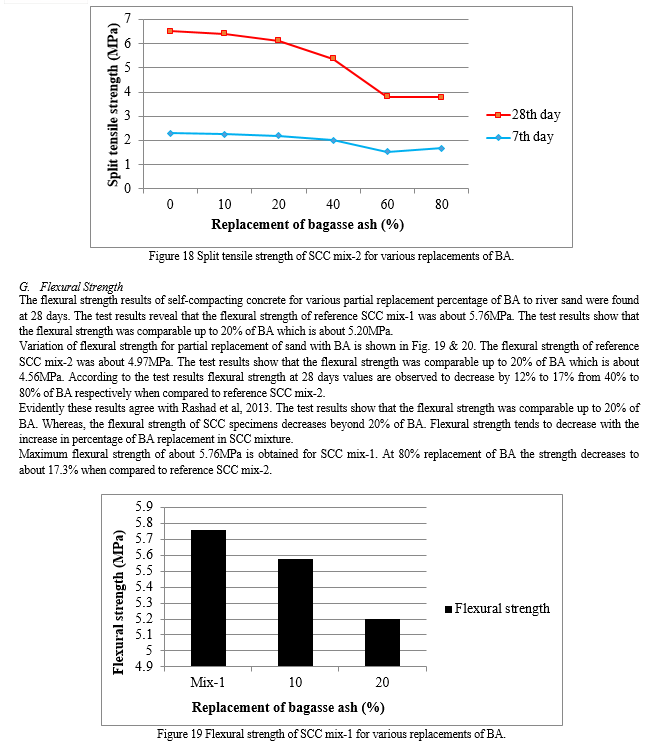
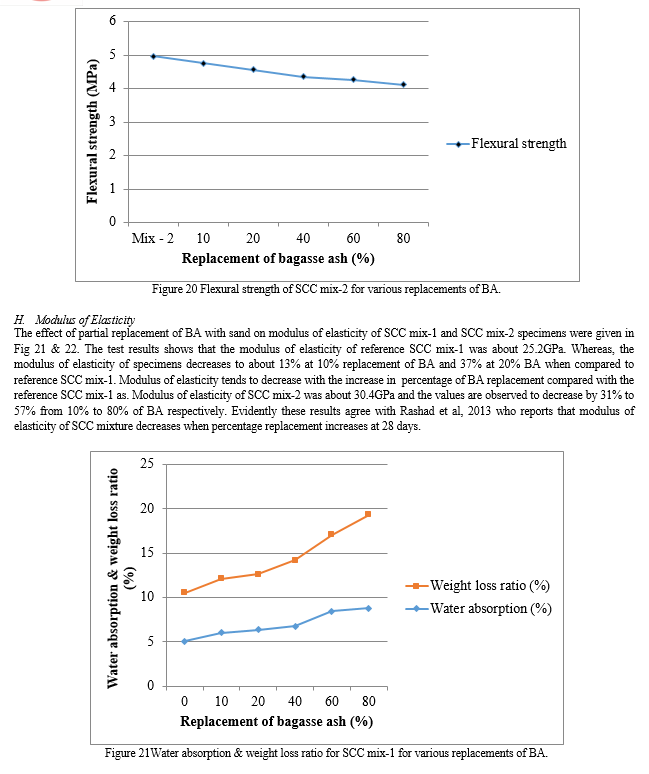
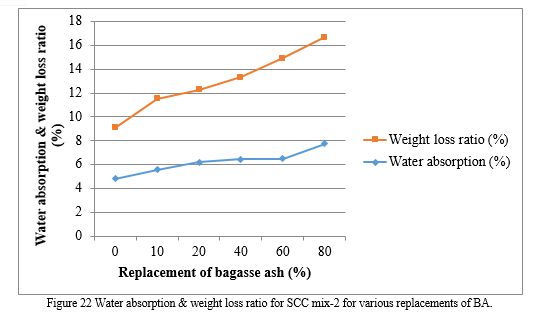
Conclusion
1) Workability of the SCC mixtures depends on BA content, mainly due to its increased water requirement. 2) Fresh properties of both the SCC mixtures up to 20% of BA were acceptable for all the workability tests. Slump flow is satisfied for all replacements up to 80% with the increase in dosage of SP and water content. However, some blocking is observed in mix containing 40% to 80% of BA in J-ring and V-funnel tests. 3) Fresh and hardened density of concrete was decreased as the percentage of BA content increased due to low bulk density of BA compared to sand. 4) Compressive strength of self compacting concrete was marginally increased with 10% of BA. Compressive strength development up to 20% of BA was comparable with reference SCC mix. Beyond 20% replacement level of BA, compressive strength was decreased with partial replacement of BA. 5) Maximum compressive strength of about 56.56MPa is achieved at SCC mix-2 at 10% of BA. 6) The rate of decrease in compressive strength of concrete is lesser for SCC mix-2 when compared with SCC mix-1. 7) Spit tensile strength and flexural strength of concrete was comparable at 10% and 20 % of BA to reference mix. 8) Modulus of elasticity of concrete was decreased with increase in percentage of BA. 9) Hardened properties of self-compacting concrete increases at later ages when compared to early ages.
References
[1] Aigbodion V.S, Hassan S.B, Ause T and Nyior G.B, (2010), Potential utilization of solid waste (bagasse ash), Journal of Minerals & Materials Characterization & Engineering, 9, 67-77. [2] Arjun B and Rame Gowda M, (2014). Development and study of behavior of self-compacting concrete using recycled aggregates, International Journal of Advanced Technology in Engineering and Science, 2(7). [3] Ashok Gurjar H, (2004). Mix design and testing of self consolidating concrete using florida materials, The Florida Department of Transportation, 503. [4] ASTMC 642-06, Standard test method for density, absorption, and voids in hardened concrete, American society for testing and materials. [5] Boukendakdji O, Kenai S, Kadri E H and Rouis F,(2009). Effect of slag on the rheology of fresh self-compacted concrete, Construction and Building Materials, 23, 2593–2598. [6] EFNARC(2002). The European guidelines for self-compacting concrete specification, production and use. [7] Ganesan N, Bharati Raj J and Shashikala A P,(2012). Strength and durability studies of self compacting rubberised concrete, The Indian Concrete Journal. [8] Girish S, ( 2012). Influence of powder and paste on SCC using recycled concrete aggregate, Bonfring International Journal of Industrial Engineering and Management Science, 2(4). [9] Gritsada Sua-iam and Natt Makul, (2013). Use of increasing amounts of bagasse ash waste to produce self-compacting concrete by adding limestone powder waste, Journal of Cleaner Production, 1-12. [10] Gritsada Sua-iam and Natt Makul,(2013). Use of high volume, untreated bagasse ash as a fine aggregate substitute for preparing self-compacting concrete, Research and Development Journal, 24(3). [11] Guilherme Chagas Cordeiro, Romildo Dias Toledo Filho , Luis Marcelo Tavares and Eduardo de Moraes Rego Fairbairn, (2009). Ultrafine grinding of sugar cane bagasse ash for application as pozzolanic admixture in concrete, Cement and Concrete Research, 39, 110–115. [12] Heba Mohamed A, (2011). Effect of fly ash and silica fume on compressive strength of self-compacting concrete under different curing conditions, Ain Shams Engineering Journal, 2, 79–86. [13] IS 2386 (part I)-(1963). Methods of test for aggregate for concrete-particle size and shape, BIS, New Delhi. [14] IS 2386 (part III)-(1963). Method of test for aggregate for concrete-specific gravity, density, voids absorption and bulking, BIS, New Delhi. [15] IS 383-(1970). Specification of coarse and fine aggregate from natural sources for concrete, BIS, New Delhi. [16] IS 516(1959). Methods of test for strength of concrete, BIS, New Delhi. [17] IS 5816(1999). Method of test splitting tensile strength of concrete, BIS, New Delhi. [18] IS 4031(1988). Methods of physical tests for hydraulic cement, Part 6: Determination of compressive strength of hydraulic cement, BIS, New Delhi. [19] IS 1727(1967). Methods of test for pozzolanic materials, BIS, New Delhi. [20] IS 12269(1987). 53 grade ordinary Portland cement, BIS, New Delhi. [21] Kou S.C and Poon C.S, (2009). Properties of self compacting concrete prepared with coarse and fine recycled concrete aggregates, Cement & Concrete Composites, 31, 622–627. [22] Lourdes Souza M.S, Eduardo Fairbairn M.R, Guilherme Cordeiro C and Romildo Toledo Filho D, (2012). Hydration study of sugar cane bagasse ash and calcium hydroxide pastes of various initial c/s ratios, Second International Conference on Micro structural-related Durability of Cementitious Composites,11-13. [23] Mallikarjuna Reddy V, Seshagiri Rao M.V, Srilakshmi P and Sateesh Kumar B, (2013). Effect of w/c ratio on workability and mechanical properties of high strength self compacting concrete, 7, 06-13. [24] Najim K.B and Hall M.R, (2010). A Review of the fresh/hardened properties and applications for plain (PRC) and self-compacting rubberised concrete (SCRC), Construction and Building Materials, 24, 2043–2051. [25] Nan Su and Buquan Miao,(2003). A New method for the mix design of medium strength flowing concrete with low cement content, Cement & Concrete Composites, 25, 215–222. [26] Nan Su, Kung-Chung Hsu and His-Wan Chai, (2001). A Simple mix design method for self-compacting concrete, Cement and Concrete Research ,31,1799-1807. [27] Neelam Pathak and Rafat Siddique, (2012). Properties of self-compacting- concrete containing fly ash subjected to elevated temperatures, Construction and Building Materials, 30, 274–280. [28] Prashant Modani O and Vinod Mohitkar M, (2014). Self-compacting concrete with recycled aggregate: a solution for sustainable development, International Journal of Civil and Structural Engineering, 2014, 4(3). [29] Yoyok Setyo, Hadiwidodo and Sabarudin Bin Mohd, (2009). Effect of super plasticizer and water binder ratio on fresh properties and compressive strength of SCC, Journal of Engineering and Applied sciences, 4(3), 232-235. [30] Vengadesh Marshall Raman, J & Ramasamy, V 2021, ‘Augmentation of dissimilar Technique for Enhancing the Concrete properties with Recycled Coarse Aggregate and Manufactured Sand’, Journal of Material Research and Technology, vol.14, pp.1180-1190. ISSN: 2238-7854, Impact Factor – 5.039.-Annexure I https://doi.org/10.1016/j.jmrt.2021.06.094 (Elsevier) [31] Kandasamy S, Gowthaman M , Gowdhamramkarthik P, Vengadesh Marshall Raman J, Magenthiran B,2022, “Strength and durability performance of concrete cast using permeable formwork liner’, Journal of Building Pathology and Rehabilitation (2022) 7:89, https://doi.org/10.1007/s41024-022-00231-9 (Springer) [32] J.Vengadesh Marshall Raman, R. Aswini.\"Studies on Self Compacting Fuel Dispenser Hose Pipe Rubber in Concrete\", Volume 4, Issue XII, International Journal for Research in Applied Science and Engineering Technology (IJRASET) Page No: , ISSN : 2321-9653,www.ijraset.com [33] J.Vengadesh Marshall Raman, M. Sriram .\"Experimental Investigation on Fully Replacement of Steel Slag as Course Aggregate in M30 Grade Concrete\", Volume 5, Issue II, International Journal for Research in Applied Science and Engineering Technology (IJRASET) Page No: , ISSN : 2321-9653, www.ijraset.com [34] J. Vengadesh Marshall Raman, R. Senthil Raj.\"Mechanical Studies of Self Compacting Concrete Using Plastic Aggregate\", Volume 5, Issue II, International Journal for Research in Applied Science and Engineering Technology (IJRASET) Page No: , ISSN : 2321-9653,www.ijraset.com [35] J. Vengadesh Marshall Raman, R. Kirubakaran.\"Experimental Investigation of Partial Replacement of Sand by Laterite Soil in Concrete\", Volume 5, Issue II, International Journal for Research in Applied Science and Engineering Technology (IJRASET) Page No: , ISSN : 2321-9653, www.ijraset.com [36] J.Vengadesh Marshall Raman, M. Sriram.\"Study on Replacement Level of Concrete Waste as Fine Aggregate in Concrete\", Volume 5, Issue II, International Journal for Research in Applied Science and Engineering Technology (IJRASET) Page No: , ISSN : 2321-9653,www.ijraset.com [37] J.Vengadesh Marshall Raman , K.Jaiganesan , \"Durability Study on Replacement Level of Concrete Waste as Fine Aggregate in Concrete\" Vol. 2 - Issue 2 ( January - February 2017), International Journal of Research in Engineering Technologys (IJRET) , ISSN: 2455- 1341 , www.ijretjournal.org [38] J.Vengadesh Marshall Raman , K.Jaiganesan , \"Non-Destructive Test and Durability Studies of Self Compacting Concrete Using Plastic Aggregate\" Vol. 2 - Issue 2 ( January - February 2017), International Journal of Research in Engineering Technologys (IJRET) , ISSN: 2455- 1341 , www.ijretjournal.org [39] J.Vengadesh Marshall Raman and K Ajeeth Kumar , “Studies on Partially Replacement of Municipal Solid Waste Ash as Cement in Concrete” Vol. 2, No. 2, April 2017, International Journal of civil engineering and construction structures (IJCECS), ISSN: 2455-7714, www.trpubonline.com [40] J Vengadesh Marshall Raman and R Kirubakaran,” Durability Properties on Fuel Dispenser Hose Pipe Rubber as a Coarse Aggregate in Self Compacting Concrete” Vol. 2, No. 2, April 2017 , International Journal of civil engineering and construction structures (IJCECS),ISSN:2455-7714, www.trpubonline.com [41] J Vengadesh Marshall Raman and S Kirubakaran, “ Study on Partial Replacement of Fine Aggregate by Crushed Waste Bottles in Concrete” Vol. 2, No. 2, April 2017, , International Journal of civil engineering and construction structures (IJCECS),ISSN 2455-7714, www.trpubonline.com [42] J.Vengadesh Marshall Raman, V.Murali Krishnan \"Partial Replacement of Cement with GGBS in Self Compacting Concrete for Sustainable Construction\", SSRG International Journal of Civil Engineering (SSRG-IJCE),V4(3),24-28March2017.ISSN:2348–8352. www.internationaljournalssrg.org/IJCE/index.html. Published by: Seventh Sense Research Group [43] J Vengadesh Marshall Raman and K Chellaperumal,” Study on Mechanical Properties of Glass Fiber Reinforced Concrete” Vol. 2, No. 2, April 2017, International Journal of civil engineering and construction structures (IJCECS),ISSN:2455-7714, www.trpubonline.com [44] J. Vengadesh Marshall Raman “Planning and Design of Seismic Resistant Structure using Base Isolation Technique” Vol. 6, Issue 02, 2018, IJSRD - International Journal for Scientific Research & Development, ISSN (online): 2321-0613, www.ijsrd.com. [45] J.Vengadesh Marshall Raman and N.Vijay “Experimental Study On Glass Fiber Reinforced Concrete Using Metakaolin As Mineral Admixtures” Volume 10, Issue 5, May-2019 ,IJSER - International Journal of Scientific & Engineering Research, ISSN 2229-5518 , http://www.ijser.org [46] J.Vengadesh Marshall Raman and P.Soundarya “An Experimental Study On Rapid Hardening Cement Concrete Paver Blocks By Using Corundum As A Mineral Admixture” Volume 16, Issue 3 Ser. I (May. - June. 2019),IOSR- Journal of Mechanical and Civil Engineering (IOSR-JMCE) e-ISSN: 2278-1684,p-ISSN: 2320-334X, , PP 01-09 www.iosrjournals.org [47] J.Vengadesh Marshall Raman and P.Soundarya “Planning, Designing and Estimation of High Ceiling Residential Building(G+1)” Vol. 9,Issue 5 (Series -V) May 2019, pp 60-75 ,Journal of Engineering Research and Application w.ijera.com ISSN : 2248-9622 Vol. 9,Issue 5 (Series -V) May 2019, pp 60-75 [48] J.Vengadesh Marshall Raman, V.Gnanadevi and V.Anitha “Experimental Investigation on Quarry Dust and Recycled Aggregates in Concrete”, International Journal of Civil Engineering and Applications. ISSN 2249-426X Volume 9, Number 1 (2019), pp. 1-9 © Research India Publications http:// www.ripublication.com [49] J.Vengadesh Marshall Raman, R.Rajesh and P.Sabari Velswaran “Study on Strength of High Performance Concrete by Partial Replacement of Fine Aggregate by Copper Slag” International Journal of Applied Engineering Research ISSN 0973-4562 Volume 14, Number 11 (2019) pp. 2795-2798 © Research India Publications. http://www.ripublication.com [50] J. Vengadesh Marshall Raman “Sustainable Technological Solutions For Faster And Cost Effective Construction Of Mass Housing (A Case Study Of Rapid - Monolithic - Disaster Proof Technology) “Journal of Civil Engineering and Technology (JCIET) Volume 06, Issue 01, January - December 2019, pp. 01-16. [51] Vengadesh Marshall Raman, J & Ramasamy, V 2020, ‘various treatment techniques involved to enhance the recycled the recycled coarse aggregate in concrete: A review’, Material Today Proceedings, vol.45, no.7, pp.6356-6363, ISSN: 2214-7853, Impact Factor -1.46. (Elsevier) https://doi.org/10.1016/j.matpr.2020.10.935
Copyright
Copyright © 2023 S. Sathishkumar, Mrs. P. Somiyadevi, S. Maluvu. This is an open access article distributed under the Creative Commons Attribution License, which permits unrestricted use, distribution, and reproduction in any medium, provided the original work is properly cited.

Download Paper
Paper Id : IJRASET56009
Publish Date : 2023-10-04
ISSN : 2321-9653
Publisher Name : IJRASET
DOI Link : Click Here
 Submit Paper Online
Submit Paper Online

